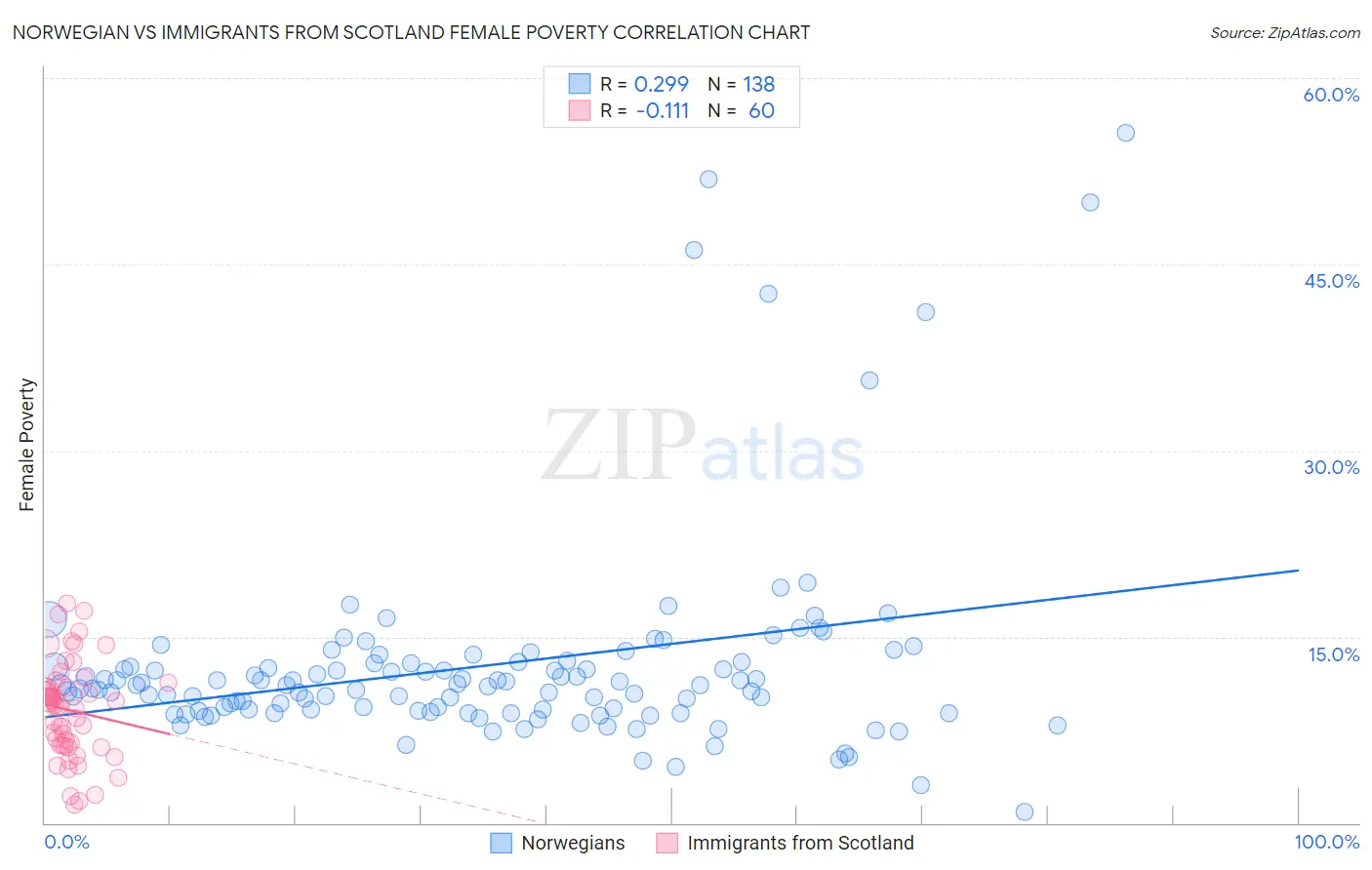Norwegian vs Immigrants from Scotland Female Poverty
COMPARE
Norwegian
Immigrants from Scotland
Female Poverty
Female Poverty Comparison
Norwegians
Immigrants from Scotland
11.5%
FEMALE POVERTY
99.8/ 100
METRIC RATING
19th/ 347
METRIC RANK
11.5%
FEMALE POVERTY
99.8/ 100
METRIC RATING
18th/ 347
METRIC RANK
Norwegian vs Immigrants from Scotland Female Poverty Correlation Chart
The statistical analysis conducted on geographies consisting of 532,481,223 people shows a weak positive correlation between the proportion of Norwegians and poverty level among females in the United States with a correlation coefficient (R) of 0.299 and weighted average of 11.5%. Similarly, the statistical analysis conducted on geographies consisting of 196,374,584 people shows a poor negative correlation between the proportion of Immigrants from Scotland and poverty level among females in the United States with a correlation coefficient (R) of -0.111 and weighted average of 11.5%, a difference of 0.040%.

Female Poverty Correlation Summary
| Measurement | Norwegian | Immigrants from Scotland |
| Minimum | 0.92% | 1.4% |
| Maximum | 55.6% | 17.7% |
| Range | 54.6% | 16.2% |
| Mean | 12.7% | 9.1% |
| Median | 11.1% | 9.5% |
| Interquartile 25% (IQ1) | 9.0% | 6.3% |
| Interquartile 75% (IQ3) | 12.9% | 10.9% |
| Interquartile Range (IQR) | 3.8% | 4.6% |
| Standard Deviation (Sample) | 8.4% | 3.8% |
| Standard Deviation (Population) | 8.4% | 3.8% |
Demographics Similar to Norwegians and Immigrants from Scotland by Female Poverty
In terms of female poverty, the demographic groups most similar to Norwegians are Bolivian (11.5%, a difference of 0.090%), Immigrants from Bolivia (11.5%, a difference of 0.16%), Eastern European (11.5%, a difference of 0.23%), Latvian (11.4%, a difference of 0.64%), and Italian (11.6%, a difference of 0.73%). Similarly, the demographic groups most similar to Immigrants from Scotland are Bolivian (11.5%, a difference of 0.050%), Immigrants from Bolivia (11.5%, a difference of 0.12%), Eastern European (11.5%, a difference of 0.27%), Latvian (11.4%, a difference of 0.59%), and Italian (11.6%, a difference of 0.77%).
| Demographics | Rating | Rank | Female Poverty |
| Immigrants | South Central Asia | 99.9 /100 | #8 | Exceptional 11.1% |
| Bulgarians | 99.9 /100 | #9 | Exceptional 11.1% |
| Immigrants | Hong Kong | 99.9 /100 | #10 | Exceptional 11.2% |
| Maltese | 99.9 /100 | #11 | Exceptional 11.2% |
| Bhutanese | 99.9 /100 | #12 | Exceptional 11.3% |
| Immigrants | Lithuania | 99.9 /100 | #13 | Exceptional 11.3% |
| Lithuanians | 99.8 /100 | #14 | Exceptional 11.4% |
| Latvians | 99.8 /100 | #15 | Exceptional 11.4% |
| Immigrants | Bolivia | 99.8 /100 | #16 | Exceptional 11.5% |
| Bolivians | 99.8 /100 | #17 | Exceptional 11.5% |
| Immigrants | Scotland | 99.8 /100 | #18 | Exceptional 11.5% |
| Norwegians | 99.8 /100 | #19 | Exceptional 11.5% |
| Eastern Europeans | 99.7 /100 | #20 | Exceptional 11.5% |
| Italians | 99.7 /100 | #21 | Exceptional 11.6% |
| Swedes | 99.7 /100 | #22 | Exceptional 11.6% |
| Burmese | 99.7 /100 | #23 | Exceptional 11.6% |
| Luxembourgers | 99.7 /100 | #24 | Exceptional 11.6% |
| Immigrants | Northern Europe | 99.6 /100 | #25 | Exceptional 11.6% |
| Croatians | 99.6 /100 | #26 | Exceptional 11.6% |
| Iranians | 99.6 /100 | #27 | Exceptional 11.7% |
| Immigrants | Korea | 99.6 /100 | #28 | Exceptional 11.7% |